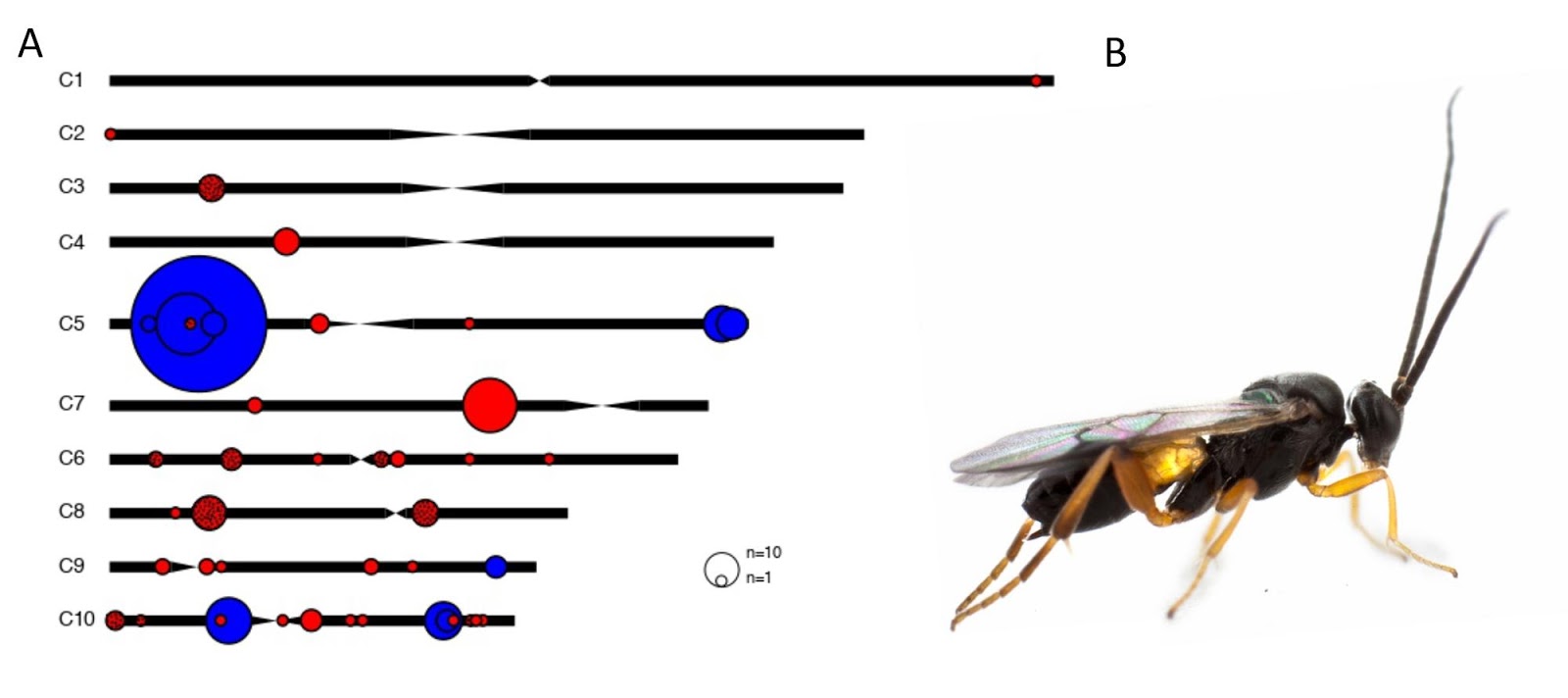Viruses are not always harmful: they can provide new functions to the animals they usually infect. The most striking example is probably the utilization by parasitic wasps named Cotesia of a virus that became integrated into their genome 100 million years ago. These wasps attack caterpillars into which their larvae develop. To do this, they produce virus particles, called bracoviruses, that are massively injected, along with their eggs, into the body of caterpillars. The particles infect host cells and the viral genes thus introduced ensure production of proteins necessary for parasitism success. These factors alter immune defenses allowing wasp larvae to survive and develop inside the caterpillar.
An international consortium (France, Netherlands, Brazil, United States) has recently shown (Communications Biology 01/22/2021, doi:10.1038/s42003-020-01623-8) that these virus genes have colonized all chromosomes of the wasps. Contrary to other viruses integrated into genomes that usually decay and are eventually lost, this endogenous bracovirus has undergone such a large genomic expansion that it became a “giant virus”. The virus sequences are dispersed all over the wasp genome, however some conserved regions contain clusters of genes involved in essential viral functions, including particle production and replication of packaged DNA genome. The largest of these regions makes up most of the short arm of one chromosome. Despite a massive production of particles, immune response is not induced, suggesting the wasp no longer perceives the bracovirus as a foreign. It seems that no conflict remains between partners and that the virus functions have been completely integrated in wasp physiology. Virus high-jacking has occurred repeatedly during parasitic wasp evolution suggesting domestication of complex viruses allowing the gene delivery to targeted organisms is a general process of evolution.


Publication
Chromosomal scale assembly of parasitic wasp genome reveals symbiotic virus colonization. Jérémy Gauthier, Hélène Boulain, Joke J.F.A. van Vugt, Lyam Baudry, Emma Persyn, Jean-Marc Aury, Benjamin Noel, Anthony Bretaudeau, Fabrice Legeai, Sven Warris, Mohamed Amine Chebbi, Géraldine Dubreuil, Bernard Duvic, Natacha Kremer, Philippe Gayral, Karine Musset, Thibaut Josse, Diane Bigot, Christophe Bressac, Sébastien Moreau, Georges Periquet, Myriam Harry, Nicolas Montagné, Isabelle Boulogne, Mahnaz Sabeti-Azad, Martine Maïbèche, Thomas Chertemps, Frédérique Hilliou, David Siaussat, Joelle Amselem, Isabelle Luyten, Claire Capdevielle-Dulac, Karine Labadie, Bruna Laïs Merlin, Valérie Barbe, Jetske G. de Boer, Martial Marbouty, Fernando Luis Cônsoli, Stéphane Dupas, Aurélie Hua Van, Gaelle Le Goff, Annie Bézier, Emmanuelle Jacquin-Joly, James B. Whitfield, Louise E.M. Vet, Hans M. Smid, Laure Kaiser-Arnault, Romain Koszul, Elisabeth Huguet, Elisabeth A. Herniou and Jean-Michel Drezen. Communications Biology.Chromosomal scale assembly of parasitic wasp genome reveals symbiotic virus colonization. Jérémy Gauthier, Hélène Boulain, Joke J.F.A. van Vugt, Lyam Baudry, Emma Persyn, Jean-Marc Aury, Benjamin Noel, Anthony Bretaudeau, Fabrice Legeai, Sven Warris, Mohamed Amine Chebbi, Géraldine Dubreuil, Bernard Duvic, Natacha Kremer, Philippe Gayral, Karine Musset, Thibaut Josse, Diane Bigot, Christophe Bressac, Sébastien Moreau, Georges Periquet, Myriam Harry, Nicolas Montagné, Isabelle Boulogne, Mahnaz Sabeti-Azad, Martine Maïbèche, Thomas Chertemps, Frédérique Hilliou, David Siaussat, Joelle Amselem, Isabelle Luyten, Claire Capdevielle-Dulac, Karine Labadie, Bruna Laïs Merlin, Valérie Barbe, Jetske G. de Boer, Martial Marbouty, Fernando Luis Cônsoli, Stéphane Dupas, Aurélie Hua Van, Gaelle Le Goff, Annie Bézier, Emmanuelle Jacquin-Joly, James B. Whitfield, Louise E.M. Vet, Hans M. Smid, Laure Kaiser-Arnault, Romain Koszul, Elisabeth Huguet, Elisabeth A. Herniou and Jean-Michel Drezen. Communications Biology.
Contact
Jean-Michel Drezen, Institut de recherche sur la biologie de l’insecte (IRBI – CNRS / Université de Tours)






